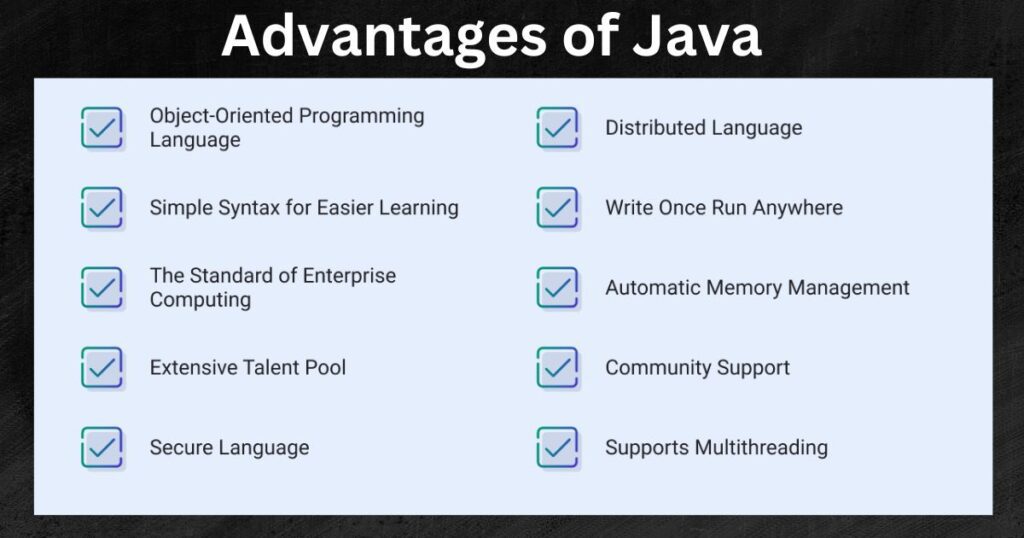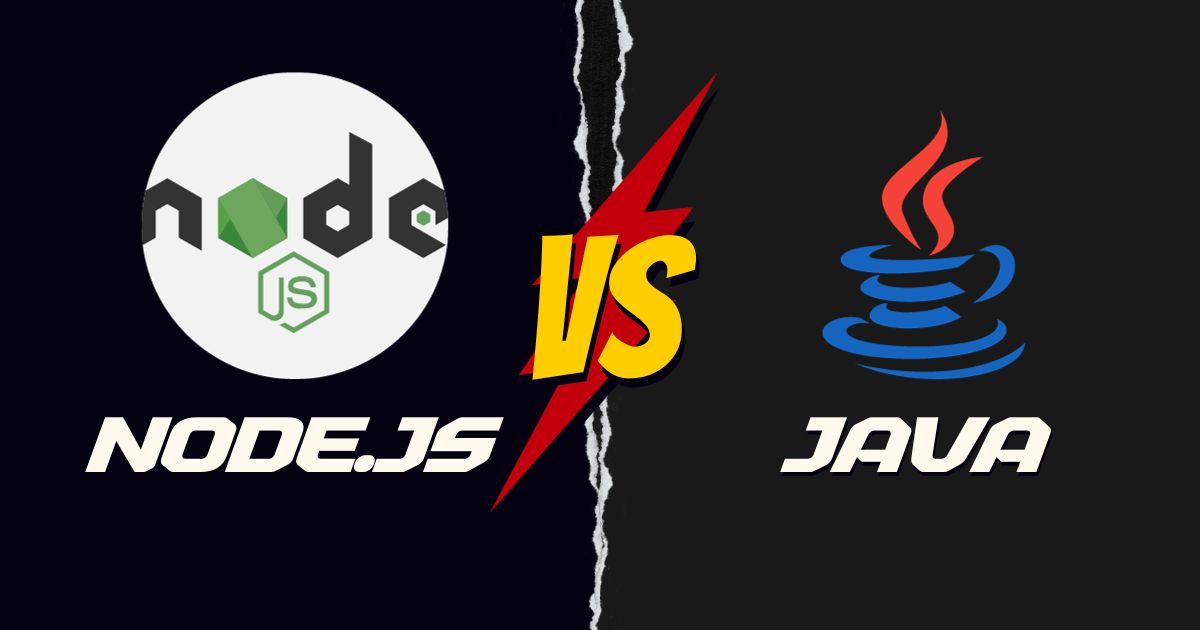In the rapidly evolving tech landscape of today, the selection of technology plays a pivotal role in determining the success of a project. When it comes to Node.js vs. Java, these two technologies emerge as formidable contenders, each possessing distinct strengths and considerations. This comprehensive comparison aims to assist you in making an informed decision for your upcoming project.
Node.js and Java have solidified their positions as primary choices in the expansive realm of programming languages. Choosing between them necessitates a meticulous examination of various factors to ensure that the selected technology aligns seamlessly with the specific requirements of the project. Let’s delve into the intricacies of Node.js and Java, shedding light on the critical aspects that shape the decision-making process.
Node.js: A Deeper Look

Let’s take a closer look at Node.js, a tool for building websites and apps that stands out for its speed and efficiency. We’ll explore why it’s great, where it works well, and a few things to consider.
Advantages of Node.js
Node.js, leveraging the Chrome V8 JavaScript engine, stands out for its distinctive non-blocking, event-driven architecture. This design choice results in exceptional speed and scalability, making it a preferred platform for various applications. The lightweight nature of Node.js allows it to efficiently handle concurrent connections, a critical feature that elevates its suitability for real-time applications.
The non-blocking architecture is particularly advantageous when dealing with I/O-bound tasks, ensuring that the application remains responsive even during data-intensive operations. This characteristic makes Node.js an attractive choice for developers working on projects where responsiveness and scalability are paramount.
Use Cases and Industries Benefiting from Node.js
The versatility of Node.js extends across a myriad of industries, finding applications in scenarios demanding real-time performance and efficient handling of large datasets. Streaming services, with their real-time content delivery requirements, benefit significantly from Node.js. Its ability to seamlessly manage multiple connections concurrently makes it a go-to solution for streaming platforms, ensuring a smooth and uninterrupted user experience.
E-commerce platforms, with their dynamic and data-intensive nature, also find Node.js to be an invaluable tool. The technology’s prowess in handling large-scale, data-centric tasks makes it well-suited for applications where speed and responsiveness are critical factors. This has positioned Node.js as a favorite among developers working on e-commerce solutions seeking optimal performance and scalability.
Challenges and Considerations with Node.js
While Node.js offers a multitude of advantages, it’s not without its challenges. The single-threaded event loop architecture that contributes to its non-blocking nature can pose issues when dealing with CPU-bound tasks. In scenarios where the application requires intense computational processing, Node.js may face limitations due to its inability to efficiently utilize multi-core processors.
Developers need to carefully assess project requirements before opting for Node.js. If the project involves tasks that are primarily CPU-bound, alternative technologies may need to be considered. However, for projects that align with Node.js strengths, the benefits it brings to the table in terms of speed, scalability, and real-time capabilities can outweigh these challenges.
Java: A Robust Foundation

Java, renowned for its reliability and versatility, stands as a cornerstone in the world of programming. To truly appreciate its strength, let’s delve into the robust foundation it provides, exploring its key strengths, applications across diverse sectors, and a few considerations that developers should bear in mind.
Strengths of Java
Java’s strength lies in its “write once, run anywhere” philosophy, a powerful concept that emphasizes platform independence. This means that code written in Java can run on any device or platform without modification. This portability is crucial, especially for enterprise-level applications, where consistency across various environments is paramount.
The mature and stable ecosystem surrounding Java is another significant advantage. Over the years, Java has developed a rich set of libraries and tools, creating a well-established environment for developers. This ecosystem ensures that developers can access a comprehensive set of resources, making it easier to build robust and scalable applications.
Java’s strong typing system is also a notable feature. This means that variables must be declared with a specific data type, providing clarity and reducing the likelihood of errors during development. The comprehensive libraries available in Java further enhance its appeal, allowing developers to leverage pre-built functions and modules, saving time and effort in the development process.
Applications and Sectors Where Java Excels
Java’s versatility extends across a broad spectrum of applications and sectors, making it a go-to choice for various development needs. In the realm of enterprise solutions, where reliability and consistency are paramount, Java shines. Its ability to run on different platforms ensures that applications work seamlessly in diverse business environments.
Mobile applications also benefit from Java’s strengths. The platform independence feature allows developers to write code for Android devices, ensuring a wide reach in the mobile app landscape. Large-scale systems, such as those handling extensive databases or serving a significant number of users concurrently, find Java to be a reliable choice due to its stability and robustness.
Java’s role in mission-critical applications is noteworthy. Sectors such as finance, healthcare, and telecommunications rely on Java for applications where reliability is non-negotiable. The language’s ability to handle complex tasks with precision and its established track record in such critical domains make it a preferred technology.
Drawbacks and Considerations When Using Java
While Java boasts a range of strengths, it’s not without its considerations. One notable drawback is its verbosity, meaning that Java code can be more extensive compared to other languages. This verbosity can lead to longer development times, potentially posing challenges in projects with tight deadlines. Developers often need to weigh the benefits of Java’s stability and platform independence against the potential drawback of longer development cycles.
Teams considering Java for their projects must be mindful of the language’s characteristics and assess whether its strengths align with the project’s requirements. In situations where rapid development is crucial, alternatives may need to be explored.
Performance Comparison
Speed and Efficiency of Node.js
Node.js is a frontrunner when it comes to handling asynchronous operations, resulting in impressive speed in certain scenarios. Its architecture, built upon the Chrome V8 JavaScript engine, adopts an event-driven model. This unique approach ensures minimal latency, making Node.js particularly well-suited for applications requiring rapid and simultaneous user interactions.
The strength of Node.js lies in its ability to efficiently manage multiple tasks concurrently. In real-time applications, such as chat systems or collaborative tools, where the need for quick and simultaneous processing is paramount, Node.js excels. The non-blocking nature of its event loop allows for seamless execution of tasks without waiting for one to finish before starting another, contributing to reduced response times and an enhanced user experience.
Java’s Performance Metrics and Benchmarks
Java, with its compiled nature, emerges as a stalwart showcasing robust performance, especially in CPU-intensive tasks. The Java Virtual Machine (JVM) optimizes resource utilization, empowering Java applications to handle computationally intensive operations with efficiency. This characteristic makes Java an optimal choice for projects where stability and predictability are key priorities.
In situations where the workload involves heavy computations, data processing, or intricate algorithms, Java’s compiled nature provides a significant performance advantage. The bytecode compilation and optimization process contribute to faster execution, making Java a reliable option for tasks that demand substantial processing power.
Real-World Scenarios and Implications on Choice
Choosing between Node.js and Java demands a realistic evaluation of project requirements, workload specifics, user interactions, and performance expectations. Each technology excels in distinct scenarios, and understanding their strengths is crucial for making an informed decision.
- Node.js for Real-Time Applications: Node.js stands out when real-time interactions and low-latency responses are critical. Its event-driven architecture is tailor-made for handling simultaneous connections, making it an excellent choice for scenarios like live chats or collaborative editing.
- Java for CPU-Intensive Operations: On the other hand, Java proves its mettle in scenarios involving intensive computational tasks or large-scale data processing. The compiled nature of Java allows it to optimize resources effectively, making it a robust choice for handling complex algorithms and calculations.
In the performance comparison between Node.js and Java, there is no one-size-fits-all answer. The choice hinges on the specific needs of the project. Node.js impresses with its speed and efficiency in handling asynchronous operations, making it ideal for real-time applications. Java, with its compiled nature, excels in CPU-intensive tasks, providing stability and predictability.
Scalability
Scalability is a key factor in the success of any technology, and both Node.js and Java offer distinctive features in this regard. Let’s explore the scalability features of Node.js and Java, understanding their strengths and how they align with various project requirements.
Node.js Scalability Features
Node.js stands out for its prowess in horizontal scalability, a method where developers can effortlessly add more nodes to the system. The lightweight architecture of Node.js facilitates this process, making it easy to scale applications based on demand. Horizontal scalability is particularly beneficial in scenarios where handling a growing number of users or requests is crucial.
The ability to scale horizontally means that as the user base or workload increases, developers can expand the system by adding more servers or nodes. This flexibility allows applications built with Node.js to efficiently manage increased traffic and demand without significant reconfiguration.
Java’s Scalability Capabilities
In contrast, Java is known for its vertical scalability, which involves maximizing the utilization of additional resources on a single node. This means that, instead of adding more servers, Java allows applications to make better use of the resources within a single server. Java’s approach is particularly advantageous when dealing with tasks that require more computational power or memory.
Vertical scalability is well-suited for applications that may not necessarily need to spread across multiple servers but rather demand enhanced performance from a single server. Java’s ability to efficiently utilize the resources on a single node makes it a robust choice for scenarios where vertical scaling is more suitable.
Determining the Right Fit Based on Project Requirements
Choosing between Node.js and Java depends significantly on the scalability needs of a project. The projected user base and growth potential are crucial factors in making this decision.
For projects anticipating a rapid increase in users or a fluctuating workload, Node.js with its horizontal scalability features may be the preferred choice. Its ability to easily expand by adding more nodes aligns well with the dynamic nature of such scenarios.
On the other hand, projects with specific tasks that demand more computational power or memory may find Java’s vertical scalability more suitable. Assessing the scalability requirements, growth projections, and the nature of the tasks the application will handle will guide the decision-making process.
Community Support and Ecosystem
Node.js Community Dynamics: A Hub of Innovation
Node.js boasts a vibrant and active community, acting as a hub for innovation and collaboration. The community’s energy is palpable, contributing to the continuous development and evolution of the Node.js ecosystem. This dynamic environment fosters the creation of a plethora of open-source modules, expanding the toolkit available to developers.
The wealth of open-source modules allows developers to leverage pre-built solutions, reducing development time and effort. The constant influx of ideas and contributions ensures that the Node.js ecosystem stays agile, adapting to emerging trends and addressing evolving challenges. This community-driven approach not only accelerates development but also encourages creative problem-solving.
Java’s Vast Ecosystem and Strong Community Support: A Pillar of Reliability
In the world of Java, a vast and well-established ecosystem is bolstered by strong community support. Java has stood the test of time, accumulating a wealth of libraries, frameworks, and experienced developers. This extensive ecosystem provides developers with a robust foundation to build upon, ensuring reliability and stability in their projects.
The availability of a myriad of libraries and frameworks in the Java ecosystem empowers developers to choose the most suitable tools for their specific needs. The collective knowledge and experience within the Java community contribute to a supportive environment, where developers can seek guidance, share insights, and collaborate on solving complex problems.
Evaluating the Impact on Development and Troubleshooting
The level of community support directly influences the pace of development and the efficiency of issue resolution. In the case of Node.js, the active community translates to a quick exchange of ideas and solutions. Developers can tap into a wealth of knowledge, rapidly overcoming challenges and pushing the boundaries of innovation.
Similarly, Java’s strong community support means that developers have access to an extensive pool of resources. Whether facing complex technical issues or seeking best practices, the collaborative nature of the Java community contributes to a reliable support system.
Considerations for Technology Choice
When making technology decisions, it’s crucial to consider the impact of community engagement and available resources. The Node.js community’s innovative spirit and the continuous development of open-source modules contribute to agility and rapid development. On the other hand, Java’s extensive ecosystem and experienced community offer a stable and reliable environment for development.
The vibrancy of the community and the strength of the ecosystem are vital aspects to weigh when choosing between Node.js and Java. The collaborative spirit, innovation, and wealth of resources provided by these communities directly impact development speed, issue resolution, and the overall success of projects. Evaluating these factors ensures a technology choice aligned with the unique needs and goals of each development endeavor.
Use Case Considerations
Specific Scenarios Where Node.js Shines
Node.js emerges as a star performer in scenarios requiring real-time interactions. Applications like chat platforms and collaborative tools benefit immensely from Node.js’s prowess. The secret lies in its event-driven architecture, which proves highly effective in managing concurrent connections. This makes Node.js an ideal choice for applications where responsiveness and seamless real-time communication are paramount.
Java’s Optimal Applications and Use Cases: Enterprise, Mobile, and Mission-Critical Systems
Java, with its robust and mature nature, finds optimal applications across a spectrum of scenarios. It shines brightly in large-scale enterprise applications, where reliability and scalability are non-negotiable. Its adaptability extends to mobile development, making it a preferred choice for building robust and platform-independent mobile applications. Additionally, Java’s stability positions it as a suitable candidate for mission-critical systems where performance is crucial.
Tailoring the Technology Choice to Project Needs: A Customized Approach
The key to a successful technology choice lies in understanding and aligning with project requirements. Instead of adopting a one-size-fits-all mentality, developers must carefully analyze their project’s specific needs. This involves considering factors such as the nature of real-time interactions, the scale of enterprise applications, or the platform independence crucial for mobile development.
By tailoring the technology choice to project needs, developers can ensure optimal performance and efficiency. This approach involves a nuanced understanding of the project’s goals, expected user interactions, and scalability requirements. It ensures that the selected technology not only meets the immediate needs of the project but also aligns with its long-term objectives.
In the complex decision-making process of selecting between Node.js and Java, understanding their strengths in specific use cases is pivotal. Node.js excels in real-time interactions, while Java proves versatile in enterprise, mobile, and mission-critical applications. The key takeaway is the importance of a tailored approach to technology selection, where the unique needs of each project guide the decision-making process. By carefully analyzing use case considerations, developers can navigate the tech landscape with precision, ensuring the chosen technology aligns seamlessly with the project’s goals and requirements.
Node.js vs. Java
FAQs
- Which is better for real-time applications in Node.js vs. Java?
- The choice depends on the specific requirements of your real-time application. Node.js excels in handling concurrent connections, making it ideal for scenarios like chat applications.
- Is Java more suitable for large-scale enterprise solutions?
- Yes, Java’s robustness and platform independence make it well-suited for large-scale enterprise applications that demand stability and reliability.
- What factors should I consider when choosing between Node.js and Java for my project?
- Critical factors include performance, scalability, learning curve, and community support. Assess these in alignment with your project’s unique needs.
- Can my team’s existing expertise influence the choice between Node.js and Java?
- Absolutely. Consider your team’s skills and familiarity with the technologies when making the decision. Rapid development may favor Node.js, while Java may be preferred by teams experienced in its syntax.
- How do I stay informed about the latest trends in Node.js and Java?
- Regularly follow community forums, official documentation, and industry publications to stay updated on the latest trends, updates, and advancements in both Node.js and Java.
